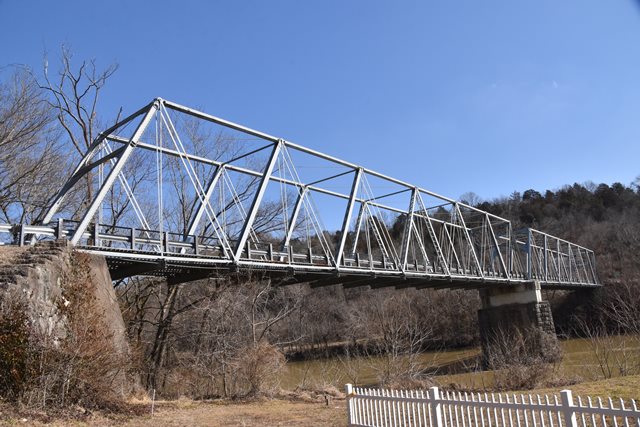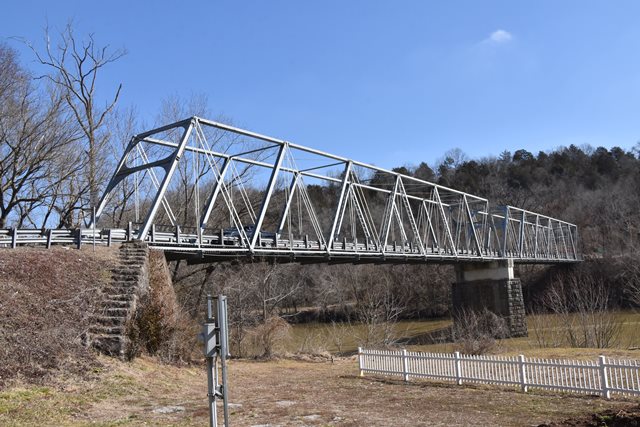We Recommend:
Bach Steel - Experts at historic truss bridge restoration.
BridgeHunter.com Phase 1 is released to the public! - Visit Now
Old Clay's Ferry Bridge

Primary Photographer(s): Nathan Holth
Bridge Documented: July 8, 2013, November 29, 2017, and February 25, 2021
Rural: Fayette County, Kentucky and Madison County, Kentucky: United States
1869 By Builder/Contractor: Louisville Bridge and Iron Company of Louisville, Kentucky and Engineer/Design: Albert Fink
1955
217.0 Feet (66.1 Meters)
443.0 Feet (135 Meters)
16.4 Feet (5 Meters)
2 Main Span(s)
034B00010N

View Information About HSR Ratings
Bridge Documentation
View Archived National Bridge Inventory Report - Has Additional Details and Evaluation
View Information About Another Major Bridge Built By This Company in Louisville
This bridge is one of the most important historic bridges in Kentucky. Several aspects of this bridge make it nationally significant. First, the bridge was built in 1869, which makes it among the oldest metal bridges in the country. Any metal bridge dating to before 1870 is exceedingly rare in North America. The other most significant aspect of this bridge is its use of cast iron for primary structural members, which is one of the rarest features to be found on a historic bridge. Cast iron truss bridges are one of the rarest types of historic bridge in the country. This bridge uses cast iron for its top chord. Additionally, the struts for this bridge are also cast iron. Finally, the bridge is also significant as a rare example of a pin-connected Warren truss. Warren trusses usually have riveted connections.
Little was known about the history of this bridge's design and construction. HistoricBridges.org located an advertisement on the Kentucky Digital Library listing the Louisville Bridge and Iron Company of Louisville, Kentucky, so this is who HistoricBridges.org is listing as the main builder for the bridge. Previously, Madison County Historical society suggested that William Gunn built the bridge. It is not known if this is speculation, or if he was perhaps the on-site contractor who erected the bridge. Madison County Historical provided the following information about Gunn:
William Gunn was born in North Carolina in 1797. He became an itinerant preacher for the Methodist Episcopal Church's Henderson, Kentucky circuit in 1819. He married Frances Adams, the daughter of a Shelbyville, Kentucky, Methodist minister, in 1826. Their children included William Gunn the younger, who was an engineer and inventor. During the Civil War, he served as chief engineer of the U.S. Military Railroad and constructed several forts in Kentucky. After the war, he built the bridge at Clay's Ferry, Kentucky and invented the "H" column for steel construction.
The history of the bridge's use is a little more well documented. Before there was a bridge here, someone named Green Clay operated a ferry service here, accounting for the name of the bridge. The bridge was built in 1869 for the Richmond and Lexington Turnpike. The bridge was purchased by the State of Kentucky in 1929 and became part of US-25 until a larger high level bridge was built to realign US-25 in 1946. Since then, the cast iron truss has carried local traffic only. The bridge was rehabilitated in 1955. At some point, the top of the pier was removed and replaced with concrete. The primary substructure material is stone, although concrete has been used to repair the abutments as well.
![]()
Photo Galleries and Videos: Old Clay's Ferry Bridge
2017-2021 Bridge Photo-Documentation
Original / Full Size PhotosA collection of overview and detail photos. This gallery offers photos in the highest available resolution and file size in a touch-friendly popup viewer.
Alternatively, Browse Without Using Viewer
![]()
2017-2021 Bridge Photo-Documentation
Mobile Optimized PhotosA collection of overview and detail photos. This gallery features data-friendly, fast-loading photos in a touch-friendly popup viewer.
Alternatively, Browse Without Using Viewer
![]()
2013 Bridge Photo-Documentation
Original / Full Size PhotosA collection of overview and detail photos. This gallery offers photos in the highest available resolution and file size in a touch-friendly popup viewer.
Alternatively, Browse Without Using Viewer
![]()
2013 Bridge Photo-Documentation
Mobile Optimized PhotosA collection of overview and detail photos. This gallery features data-friendly, fast-loading photos in a touch-friendly popup viewer.
Alternatively, Browse Without Using Viewer
![]()
Maps and Links: Old Clay's Ferry Bridge
Coordinates (Latitude, Longitude):
Search For Additional Bridge Listings:
Bridgehunter.com: View listed bridges within 0.5 miles (0.8 kilometers) of this bridge.
Bridgehunter.com: View listed bridges within 10 miles (16 kilometers) of this bridge.
Additional Maps:
Google Streetview (If Available)
GeoHack (Additional Links and Coordinates)
Apple Maps (Via DuckDuckGo Search)
Apple Maps (Apple devices only)
Android: Open Location In Your Map or GPS App
Flickr Gallery (Find Nearby Photos)
Wikimedia Commons (Find Nearby Photos)
Directions Via Sygic For Android
Directions Via Sygic For iOS and Android Dolphin Browser
USGS National Map (United States Only)
Historical USGS Topo Maps (United States Only)
Historic Aerials (United States Only)
CalTopo Maps (United States Only)




